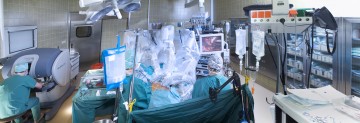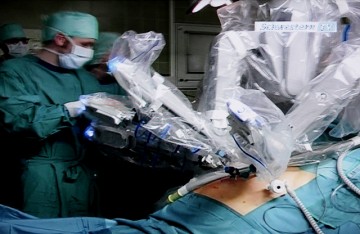da Vinci Surgical Robot
The da Vinci robot from the "Hospital of the Sisters of Mercy" in Linzmakes it possible to perform complex operations that are minimally invasive to the human body. During these procedures, the surgeon steers the robot via hand motions and foot pedals, and the robot carries out these movements in real time. The da Vinci features four robotic arms that are inserted into the body through 1- to 2-cm incisions. On the ends of the arms are fine surgical instruments that can be maneuvered three-dimensionally just like the human wrist and thus allow for extremely precise sequences of actions. Tiny cameras on the ends of the arms send high-resolution images to the surgeon stationed at the da Vinci console. There, all tissue layers and structures can be studied in detail and enlarged up to 30x. The numerous potential advantages offered by this surgical method include shortened hospital stay, less pain, low risk of infection, less blood loss, reduced scarring and fast recovery. All surgery to remove a cancerous prostate performed in Linz since 2008 has been done with da Vinci. To date, 400 prostate patients have successfully undergone this operation. Other areas of application include renal pelvis grafts and nephron-sparing surgery to remove renal tumors.
credit: Krankenhaus der Barmherzigen Schwestern
DA VINCI System
The da Vinci robot from the "Hospital of the Sisters of Mercy" in Linzmakes it possible to perform complex operations that are minimally invasive to the human body. During these procedures, the surgeon steers the robot via hand motions and foot pedals, and the robot carries out these movements in real time. The da Vinci features four robotic arms that are inserted into the body through 1- to 2-cm incisions. On the ends of the arms are fine surgical instruments that can be maneuvered three-dimensionally just like the human wrist and thus allow for extremely precise sequences of actions. Tiny cameras on the ends of the arms send high-resolution images to the surgeon stationed at the da Vinci console. There, all tissue layers and structures can be studied in detail and enlarged up to 30x. The numerous potential advantages offered by this surgical method include shortened hospital stay, less pain, low risk of infection, less blood loss, reduced scarring and fast recovery. All surgery to remove a cancerous prostate performed in Linz since 2008 has been done with da Vinci. To date, 400 prostate patients have successfully undergone this operation. Other areas of application include renal pelvis grafts and nephron-sparing surgery to remove renal tumors.
credit: rubra
Bild: Ars Electronica


